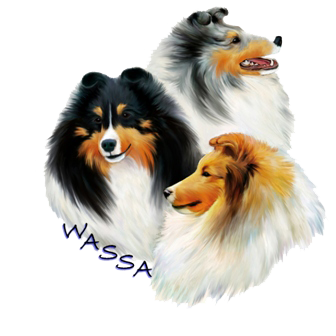
Sheltie History
The Shetland Islands make up a
group of approximately 100 islands, about 50 miles off the northern
coast of Scotland, and almost as far north as Norway. Of all the
islands, only about 25 are inhabited. The largest of these islands is
called Mainland. It is about 60 miles in length, and 20 miles at its
widest and just 50 yards at its smallest width - where one can throw a
stone from the Atlantic Ocean into the North Sea.
The islands are as rugged as they are beautiful, with rocky
coastlines, harsh and damp climate, coastal storms, and sparseness of
vegetation and grazing lands. Because of this sparseness of vegetation
and grazing areas, the islands are known for producing livestock in
diminutive size... from their cattle, to the world famous Shetland
Pony... to their sheep whose long, soft wool has made Shetland wool
products in demand the world over... to their beautiful Shetland
Sheepdog, with its look of a collie in miniature.
In the beginning the Islands first inhabitants were a small dark
race of people - the Picts - who gave the land its reputation for being
inhabited by "pixies" or fairies. Later the Norsemen overran the
Islands, and then the Scots as well, so that today, the inhabitants are a
combination of the native breeds of each of these peoples.
At one point, the Sheltie was known as the "Toonie" dog. The theory
behind the name is that since many of the islanders were of Norwegian
ancestry, and the Norwegian word for small farm is "Tun or "Toon"...
thus the name Toonie, or small farm dog.
The chief job of the Sheltie was not just to herd cattle or sheep as
is commonly thought of all herding breeds, but their job was also to
keep the small ponies, cattle, sheep, and water fowl out of the gardens
and flower beds found on the farms of the homesteaders. They did not
have huge flocks or herds to maintain, because there were not huge
flocks or herds found on the island... what herding they did was in
addition to their ability to chase away the livestock that threatened to
eat the garden and flowers of the homesteaders.
This background probably explains why the Sheltie of today are
homebodies that prefer to be busy little bees around the yard, chasing
and often barking at anything that moves, eager to please, and intensely
loyal to its family. The islanders selected their dogs for these
qualities, as well as for their ability to work, stamina, courage, and
intelligence - a trait which can still be seen in the modern Shelties of
today.
The
Sheltie was originally recognized as the "Shetland Collie", but early
Collie breeders objected to the name and it was ultimately changed to
the Shetland Sheepdog. They were originally not supposed to exceed 12
inches nor 14 pounds according to the Shetland Stud book set up in 1908.
Official recognition from the Kennel Club (English) occurred in 1909.
The first Sheltie standard was written in 1910, at which time the
height was raised to 15 inches.
Shelties were first registered in the United States in 1911 but
there was no real interest in the breed until 1924 when Catherine
Coleman Moore began "Sheltieland" Kennels by importing an English female
"Kilvarock Lassie." As a result, all of the founding stock for
American, and subsequently Canadian Shelties trace to English dogs. The
modern American/Canadian Sheltie is descended almost entirely from dogs
imported from England between World Wars I and II.
Of the dogs registered between 1909 and 1926, 42% were black and tan
with no white (a colour we no longer see). 18% of the dogs registered
were tricolours, 15% were sables, 4% black and white and 8% sable and
white. Other colours recorded where chocolates, browns, blacks, brindled
sable, and white black and tan. The Blue Merle colour was introduced
into the breed after they were brought to England and crossed with
Collies.
Interestingly enough, the most popular colour in the first part of the
century (black and tan no white) is virtually extinct having been bred
out over the years. The solid coated colors - those having no white -
and which originally accounted for at least half the original
registrations - are gone from the breed. And one of the least popular
colours of the time, the sable and white, is now by far, one of the most
popular colour of the Sheltie. Originally coats were sparse and light
since a heavy coat was a detriment to a working dog, but over the years,
as popularity demanded, coats in fullness and length at about the same
rate as the Collie's over the past 75 years to the more heavily coat dog
we see today.
Both the Canadian Kennel Club and the American Kennel Club presently
recognize the breed in the Herding Group. The current size standard in
both countries is 13-16 inches at the withers.
The Sheltie we love today were once the homesteaders working
partners, sharing their lives during long winters and summer days,
caring for their flocks, and guarding their property. This close
association with humans, plus the instinct of generations of herding
dogs in his genetic makeup, gave the Sheltie uncanny understanding of
people and an intense sense of loyalty and responsibility... a trait
which they still exhibit in today's modern world, making the Sheltie one
of the most endearing and popular breeds of dogs in North America.
For more information please visit Sue Ann Bowling's Sheltie History Pages

